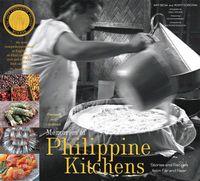Advertisement
Kinilaw
Appears in
By Amy Besa and Romy Dorotan
Published 2006
Kinilaw is a Filipino tradition of immediacy and locality, a dish prepared and consumed the moment the products are harvested from the sea. It’s a philosophy of matching the delicate texture of a raw, just-caught oyster, clam, shrimp, crab, or tuna with a tart dressing of vinegar, lime, or citrus juice, taking care not to “overcook” the fresh catch, then seasoning with ginger, onions, chiles, or coconut milk.
Kinilaw is probably the oldest known cooking method used by the early inhabitants of the Philippines. Archaeological digs in Butuan City, Mindanao, have unearthed “edible discards” of fishbones and remains of a fruit core called tabon-tabon from thousands of years ago. Today some regions in the Visayas and Mindanao still use prehistoric fruits like the tabon-tabon and dungon, grating, squeezing, and soaking the core of the fruit in water, then cleansing the fish in this fruit water before combining it with other ingredients, a process some claim makes kinilaw more digestible.

